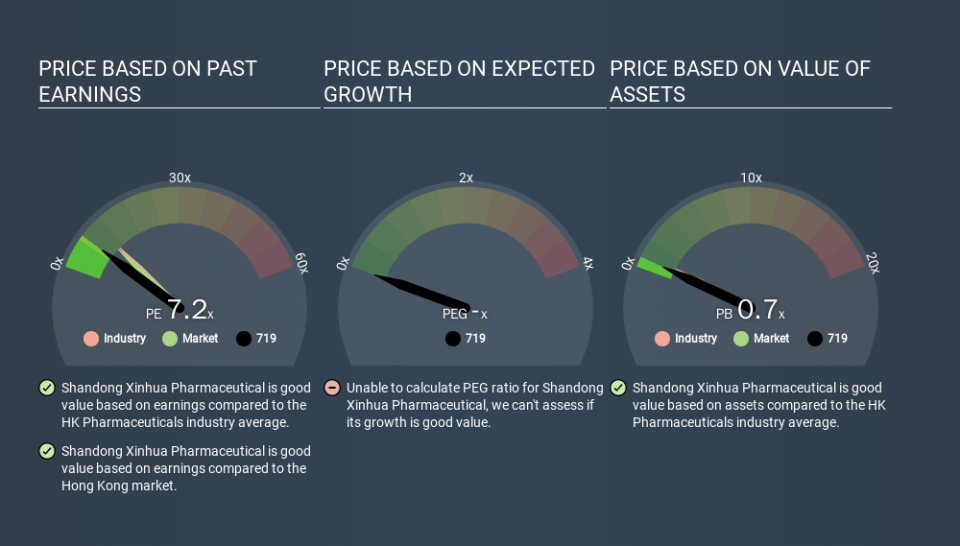Is Shandong Xinhua Pharmaceutical Company Limited's (HKG:719) P/E Ratio Really That Good?

Today, we'll introduce the concept of the P/E ratio for those who are learning about investing. We'll show how you can use Shandong Xinhua Pharmaceutical Company Limited's (HKG:719) P/E ratio to inform your assessment of the investment opportunity. Shandong Xinhua Pharmaceutical has a P/E ratio of 7.17, based on the last twelve months. In other words, at today's prices, investors are paying HK$7.17 for every HK$1 in prior year profit.
Check out our latest analysis for Shandong Xinhua Pharmaceutical
How Do I Calculate A Price To Earnings Ratio?
The formula for P/E is:
Price to Earnings Ratio = Share Price (in reporting currency) ÷ Earnings per Share (EPS)
Or for Shandong Xinhua Pharmaceutical:
P/E of 7.17 = HK$3.37 (Note: this is the share price in the reporting currency, namely, CNY ) ÷ HK$0.47 (Based on the year to September 2019.)
Is A High Price-to-Earnings Ratio Good?
A higher P/E ratio means that investors are paying a higher price for each HK$1 of company earnings. That isn't a good or a bad thing on its own, but a high P/E means that buyers have a higher opinion of the business's prospects, relative to stocks with a lower P/E.
Does Shandong Xinhua Pharmaceutical Have A Relatively High Or Low P/E For Its Industry?
One good way to get a quick read on what market participants expect of a company is to look at its P/E ratio. The image below shows that Shandong Xinhua Pharmaceutical has a lower P/E than the average (10.8) P/E for companies in the pharmaceuticals industry.
This suggests that market participants think Shandong Xinhua Pharmaceutical will underperform other companies in its industry. Since the market seems unimpressed with Shandong Xinhua Pharmaceutical, it's quite possible it could surprise on the upside. If you consider the stock interesting, further research is recommended. For example, I often monitor director buying and selling.
How Growth Rates Impact P/E Ratios
Probably the most important factor in determining what P/E a company trades on is the earnings growth. When earnings grow, the 'E' increases, over time. And in that case, the P/E ratio itself will drop rather quickly. Then, a lower P/E should attract more buyers, pushing the share price up.
Notably, Shandong Xinhua Pharmaceutical grew EPS by a whopping 27% in the last year. And its annual EPS growth rate over 5 years is 40%. With that performance, I would expect it to have an above average P/E ratio.
Don't Forget: The P/E Does Not Account For Debt or Bank Deposits
Don't forget that the P/E ratio considers market capitalization. That means it doesn't take debt or cash into account. In theory, a company can lower its future P/E ratio by using cash or debt to invest in growth.
While growth expenditure doesn't always pay off, the point is that it is a good option to have; but one that the P/E ratio ignores.
Shandong Xinhua Pharmaceutical's Balance Sheet
Shandong Xinhua Pharmaceutical has net debt worth 21% of its market capitalization. This could bring some additional risk, and reduce the number of investment options for management; worth remembering if you compare its P/E to businesses without debt.
The Bottom Line On Shandong Xinhua Pharmaceutical's P/E Ratio
Shandong Xinhua Pharmaceutical trades on a P/E ratio of 7.2, which is below the HK market average of 10.2. The company does have a little debt, and EPS growth was good last year. If the company can continue to grow earnings, then the current P/E may be unjustifiably low.
Investors have an opportunity when market expectations about a stock are wrong. If it is underestimating a company, investors can make money by buying and holding the shares until the market corrects itself. Although we don't have analyst forecasts shareholders might want to examine this detailed historical graph of earnings, revenue and cash flow.
Of course, you might find a fantastic investment by looking at a few good candidates. So take a peek at this free list of companies with modest (or no) debt, trading on a P/E below 20.
If you spot an error that warrants correction, please contact the editor at editorial-team@simplywallst.com. This article by Simply Wall St is general in nature. It does not constitute a recommendation to buy or sell any stock, and does not take account of your objectives, or your financial situation. Simply Wall St has no position in the stocks mentioned.
We aim to bring you long-term focused research analysis driven by fundamental data. Note that our analysis may not factor in the latest price-sensitive company announcements or qualitative material. Thank you for reading.


